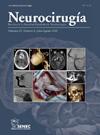Modelo de entrenamiento neuroquirúrgico en encéfalo bovino para resección de tumores intraaxiales
IF 0.8
4区 医学
Q4 NEUROSCIENCES
引用次数: 0
Abstract
Background
Practice in simulation models optimizes learning and manual skills necessary in neurosurgical training.
Objectives
To describe a neurosurgical simulation model for the resection of brain tumors using easily accessible materials and to evaluate the acceptance of the model through a questionnaire.
Material and methods
An artificial tumor based on gelatin and spongostan with infiltrative characteristics was elaborated. It was injected into a bovine brain and the latter into a dry skull. Its location was studied to later operate it using microsurgical instruments. Dural opening, corticotomy, biopsy and debulking with supramarginal resection were performed and the participants evaluated the model through a Likert-type questionnaire.
Results
In vivo simulation models, cadaveric preparations, 3D printing, virtual reality and injection of artificial lesions into animal brains ex vivo are described. In the latter, the creation of tumors based on different materials, including gelatin, is mentioned. It is important that the tumor is easy to inject and resistant to heat, so a mixture of gelatin - spongostan was created. This model describes qualities to emulate tumor surgery as well as pre-surgical planning, reconstruction of the subarachnoid space and continuous instillation of artificial blood to the surgical bed.
Conclusion
An intraaxial tumor simulation model was described as a useful tool to improve surgical techniques in oncological neurosurgery. It proved to have a good degree of acceptance in the participants.
牛脑轴向内肿瘤切除神经外科训练模型
模拟模型的实践优化了神经外科训练中必要的学习和手工技能。目的建立一种易于获取的脑肿瘤切除神经外科模拟模型,并通过问卷调查的方式评价该模型的可接受性。材料和方法阐述了一种具有浸润性的基于明胶和海绵的人工肿瘤。它被注射到牛的大脑中,后者被注射到干燥的头骨中。研究了它的位置,然后用显微外科器械进行手术。进行硬脑膜切开、皮质切除术、活检和切除边缘上肿物,参与者通过likert型问卷对模型进行评估。结果描述了动物体内模拟模型、尸体制备、3D打印、虚拟现实和人工病变脑内注射。在后者中,提到了基于不同材料(包括明胶)的肿瘤的产生。重要的是,肿瘤易于注射和耐热,因此创造了明胶-海绵的混合物。该模型描述了模拟肿瘤手术以及术前计划、重建蛛网膜下腔和持续向手术床注入人工血液的特性。结论轴内肿瘤模拟模型是提高肿瘤神经外科手术技术的有效工具。它被证明在参与者中有很好的接受程度。
本文章由计算机程序翻译,如有差异,请以英文原文为准。
求助全文
约1分钟内获得全文
求助全文
来源期刊

Neurocirugia
医学-神经科学
CiteScore
1.30
自引率
0.00%
发文量
67
审稿时长
60 days
期刊介绍:
Neurocirugía is the official Journal of the Spanish Society of Neurosurgery (SENEC). It is published every 2 months (6 issues per year). Neurocirugía will consider for publication, original clinical and experimental scientific works associated with neurosurgery and other related neurological sciences.
All manuscripts are submitted for review by experts in the field (peer review) and are carried out anonymously (double blind). The Journal accepts works written in Spanish or English.
 求助内容:
求助内容: 应助结果提醒方式:
应助结果提醒方式:


